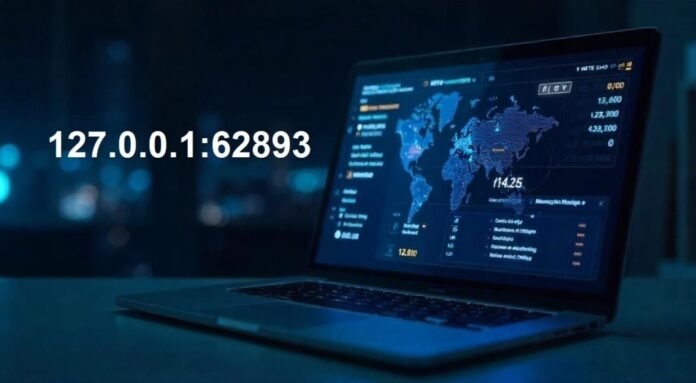If you’ve encountered the message “Unknown number 127.0.0.1:62893”, you might be wondering what it means, whether it’s a security threat, or how it affects your system. The address 127.0.0.1 is commonly referred to as localhost, a fundamental networking concept that allows devices to communicate with themselves. Meanwhile, the number 62893 represents a port, which is crucial for various software applications to function properly.
In this article, we will explore the meaning of 127.0.0.1:62893, its significance in networking, potential security implications, and troubleshooting methods.
Understanding Localhost (127.0.0.1)
What is 127.0.0.1?
The IP address 127.0.0.1 is a special-purpose address reserved for loopback or localhost communication. When a computer uses this address, it is essentially communicating with itself.
This mechanism allows developers to test applications on their local machine without the need for an external network connection. For example, when running a local web server, such as Apache or Nginx, developers often access it via 127.0.0.1.
Why is 127.0.0.1 Important?
- Software Development: Developers use localhost to test applications before deployment.
- Security & Isolation: Applications running on 127.0.0.1 cannot be accessed from other machines, ensuring a level of security.
- Efficient Networking: It allows communication within the same machine without involving external networks.
Understanding Ports and Port 62893
What is a Port?
A port is a communication endpoint that allows data to be transmitted between applications and services. Each port is identified by a number ranging from 0 to 65535, with some ports being reserved for specific protocols.
For example:
- Port 80 is used for HTTP traffic.
- Port 443 is used for HTTPS traffic.
- Port 3306 is used for MySQL database connections.
What Does Port 62893 Represent?
Port 62893 falls within the ephemeral port range (49152–65535). Ephemeral ports are dynamically assigned to client applications when they establish a connection with a server. These ports are temporary and used for short-lived communication sessions.
Why Would You See “127.0.0.1:62893”?
If you see a reference to 127.0.0.1:62893, it likely means that a program running on your computer has temporarily opened port 62893 for communication. This could be due to:
- A web server or database service running locally.
- A development framework (e.g., Node.js, Flask, Django) using a local port.
- A browser or network tool making local API calls.
- A debugging tool or a background service.
Security Implications of 127.0.0.1:62893
Since 127.0.0.1 is a loopback address, it cannot be accessed from external networks, reducing security risks. However, there are still a few concerns to be aware of:
1. Potential Malware Activity
- Some malware may use localhost to communicate internally before sending data to an external source.
- If you notice unknown services running on high-numbered ports like 62893, it is worth investigating.
2. Unauthorized Software Running
- If an unknown application is opening 127.0.0.1:62893, it could indicate unwanted software running on your system.
- You can check which application is using this port by running:
or
3. Debugging Tools and Developer Servers
- Some debugging tools (such as Chrome DevTools) may create temporary localhost connections.
- Development servers (e.g., Python’s Flask or PHP’s built-in server) often run on localhost using ephemeral ports.
Troubleshooting and Monitoring 127.0.0.1:62893
If you are concerned about the unknown number 127.0.0.1:62893, here are steps to identify and manage it:
Step 1: Identify the Process Using the Port
Use netstat or lsof to determine which application is running on port 62893.
For Windows:
- Open Command Prompt as Administrator.
- Run:
- Look for the PID (Process ID) of the application using this port.
- Identify the application by running:
For macOS/Linux:
- Open a terminal.
- Run:
- Check the output to see which process is using the port.
Step 2: Check for Background Services
Sometimes, background services like VPNs, proxies, or development tools use local ports.
- Open Task Manager (Windows) or Activity Monitor (Mac) to look for suspicious applications.
- Run:
to check active processes on Linux/macOS.
Step 3: Scan for Malware
If you cannot identify a legitimate application using 127.0.0.1:62893, perform a security scan:
- Use Windows Defender or macOS Security & Privacy settings to check for threats.
- Run a full system scan using Malwarebytes or another trusted antivirus tool.
Step 4: Restart the Service or System
- If a known service is using the port and acting abnormally, restart it.
- If the issue persists, reboot your system and recheck the port usage.
Step 5: Close Unwanted Connections
If an unknown service is using port 62893, you can terminate it:
Windows:
Linux/macOS:
Common Scenarios of 127.0.0.1:62893 Usage
1. Running a Local Web Server
Developers often use localhost to test web applications. If you are running a framework like:
- Node.js (Express.js)
- Django (Python)
- Flask (Python)
- Ruby on Rails
- PHP’s Built-in Server
It is normal to see 127.0.0.1:62893 in use as a temporary port.
2. Debugging APIs
- If you are using Postman or an API testing tool, you might see requests going to localhost on high-numbered ports.
- Web browsers also create localhost requests for various features like WebSockets.
3. VPN or Proxy Usage
Some VPNs and proxy tools use localhost to manage encrypted connections before forwarding traffic externally.
4. Docker or Virtual Machines
If you run Docker, WSL (Windows Subsystem for Linux), or virtual machines, internal network communication might show up as 127.0.0.1:62893.
Conclusion
The message “Unknown number 127.0.0.1:62893” is not necessarily a threat, but it is essential to understand its context. 127.0.0.1 is a localhost address, and 62893 is a temporary port used for internal communications.
To ensure security and system stability:
- Identify which application is using the port.
- Check for potential malware or unauthorized software.
- Use monitoring tools to track port usage.
- Close unwanted connections if needed.
